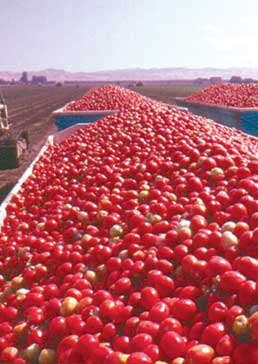
According to Sid Snitkin, vice president, ARC Advisory Group, “The ultimate goal of supply chain management (SCM) software is to enable a company and its partners to “sense and respond” to changes in the characteristics of products, the demand for products and the supply of materials used to make products in a way that, at the end of the day, always meets consumers’ needs at an optimized cost.” In the food industry Snitkin finds that, “the variation in raw product combined with the proliferation of SKUs creates significant challenges for supply chain software vendors.”
Not surprisingly, when food companies look to apply software to their supply chain processes they are confronted with a significant number of vendors and a confusing lexicon of acronyms. In addition, SCM actually encompasses a broad spectrum of business processes ranging from the cooperative development of products with suppliers through the procurement of ingredients to tracing products after they leave the production facility. All of these issues combine to make the development of a comprehensive, supply chain software solution a challenge for food manufacturers.
Elements of the chain
There are three key elements of all food supply chain processes. One is the forecast/prediction of the sell side demand for products from the consumer back to the agricultural source. Food manufacturers use the demand information to plan and schedule production and to provide their product, packaging and ingredient suppliers with orders as well as coordinate with their upstream and downstream partners.The second is the specification of products and ingredient and packaging components from suppliers through the manufacturing process and ultimately into selling channels to the consumer. Here food manufacturers develop specifications in cooperation with retailers, food service distributors, major operators and suppliers and use supply chain software to manage these specifications.
The third key element is inventory visibility. Supply Chain inventory management involves giving suppliers, manufacturers, and even customers access to information about the location and status of ingredients, in-process and finished goods. Today, much of the information captured in the food supply chain is still manually entered. Tony Lucarelli, executive vice president of sales and marketing for third party logistics provider (3PL) Henningsen Cold Storage (HCS) says, “The information embedded in the bar code label means different things to different companies. Because of this, it is difficult for public 3PLs like HCS to do much with the information electronically to improve the efficiency in the supply chain. Those who utilize RF technology must, in essence, customize applications to each customer, which requires a great deal of agreement and cooperation between the customer and the supplier.” As a result, Lucarelli says, “Much of the data from the customer bar code is still manually entered into warehouse management systems.” The consequence is that entry errors persist and information about product location and availability is not widely available throughout the supply chain on a real time basis.
Ideally, food manufacturers, and to some extent their partners, need a complete picture of their supply chain. They need accurate information about the demand that is building for their products. They need to access to up to date customer specifications and know what suppliers are putting into ingredients. And they need a picture of their inventory across their supply network to make better decisions about the scheduling of production assets.

Software requirements
The critical issue for supply chain software is that most of the sources of information are generated outside of the food manufacturing enterprise. Enterprise resource planning (ERP) software is, by definition, mostly confined to the internal workings of a company. ERP packages typically include modules like financial management, manufacturing, customer order management, and inventory management. Also, many ERP packages have a financial origin. Financial systems are built around aggregating transaction data at the financial “close” usually at the end of a month. SCM is, like ERP, transactional but the information flow differs in that it continues until the product is consumed.In addition, SCM information is generated from sources that are both internal and external to the food manufacturer. The SCM software modules may include product life cycle management, demand management, production planning, production scheduling, supply chain event management, supplier relationship management and warehousing / inventory management. Further, the information requirements are dynamic and change on an hourly basis. Supply chain data has to be aggregated in a “real time” or at least “near real time” basis to give the food manufacturer and its partners time to react to changes in demand.
These two critical factors — the requirement to obtain and distribute information across enterprises and the need to have the information be at least “near real time” make SCM applications more complex. As the supply chain vendor chart listed on page 37 indicates, no one software vendor totally covers the spectrum of SCM functionality. This means manufactures have one of three choices when they are seeking a comprehensive SCM solution. They can mix vendors for a “best of breed” solution, they can wait for their SCM vendor to expand their functionality, or they can build the missing functionality in-house.
Industry standards emerg
SCM pioneers like Wal-Mart and McDonald’s have relied on electronic data interchange (EDI) standards to communicate with their trading partners. Today, Internet technologies are being developed to streamline trading partner communication. The Meat and Poultry Data Standards Organization (mpXML) and the Uniform Code Council, Inc. (UCC) announced July 2002, that they will launch an initiative to synchronize efforts to develop global electronic trading standards. The objectives for standards include improving supply chain efficiencies, improving category management of perishables for retailers and encoding more detailed information to facilitate traceability and improve food safety.EFS Network, a company founded by Tyson Foods, McDonald’s, Cargill, and Sysco, has also announced that it is collaborating with UCC to help foodservice companies adopt and utilize the standards of the UCC system. The UCC standards are, in a sense, an Internet-based EDI that attempts to address the issues involved in distributing information across enterprises in near real time.
Practical applications increase
Even though it is still early in the lifecycle for full-featured, robust, and integrated SCM software, many companies are getting benefits from implementing SCM in niche solutions.We are seeing an increasing number of SCM applications crossing the enterprise boundaries. On the buy side, there is an urgent need to capture farm level production data that can be carried throughout the supply chain. California Tomato Growers Association members, along with a number of processors and trucking companies, are using eTomato Web based software developed by John Deere’s Agris unit to capture crop characteristics and field chemical application history as the product moves from the fields to tomato processing facilities.
In transportation, fruit and vegetable processor Seneca has been able to reduce its outbound transportation costs 2% by reengineering its freight management practices. The gains were achieved by moving from a distributed freight booking system to a web-based system developed by Nistevo. With Nistevo, Seneca gained centralized control over its freight purchases and economies from visibility to its transportation operations.
On the sell side, Welch’s practices vendor managed inventory (VMI) with key customers, and sees VMI as a critical component of customer management. The company uses the Demand Planning module of the Prescient Systems XEi suite to quickly add new customers to the VMI program, and provide them with appropriate levels of inventory.
Slim-Fast needed to improve the accuracy and speed of data flow in its production process. Managing the production, inventory, and shipping demands of an immensely popular consumer product means that Slim-Fast needs to continually evaluate and adjust its processes to keep up with requirements and maintain a competitive edge. Slim-Fast installed iWork Software from the Greensboro, NC, software vendor throughout the supply chain to integrate disparate software packages including Maximo Plant Maintenance, Unilab Quality Management, and Menlo Logistics seamlessly to Slim-Fast’s BPCS ERP software. The iWork solution is real-time data collection, which enhances ERP at the plant levels, as well as across the enterprise, allowing access to up-to-the-second inventory data.
If there is one single factor that drives the information requirements of the food supply chain it is the need to capture the information necessary to ensure food safety throughout the supply chain. To get there, the information in systems will need to be more accurate, and the software will need to be more responsive. This is leading companies like Slim-Fast and the California Tomato Growers to expect their software to enable real time information transfer from the field through the supply chain to the consumer.
Technology such as radio frequency identification (RFID), where the product information is included on a single chip that emits data on demand, may have application in the food supply chain. As the unit costs of RFID tags decrease, they may replace pallet barcode ID as the preferred way to exchange product information between supply chain partners.
Over the next 3-5 years, merging standards and technology will move the food supply chain toward the era where supply chain partners will be able to “sense and respond” to the overall needs of the supply chain.


